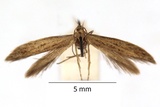Coleophora sternipennella (Zetterstedt, 1839) Species
Last modified: Nov. 28, 2025, 1:59 p.m.
A very rare species in Belgium.
Details
- Classification
- Family: Coleophoridae > Genus: Coleophora > Species: Coleophora sternipennella
- Vernacular names
- Ganzenvoetkokermot (NL), Speckled case-bearer (EN)
- Synonyms
- Coleophora flavaginella Lienig & Zeller, 1846
- First mention in Belgium
- Janmoulle E. 1954a. Espèces nouvelles pour la faune belge (suite). — Lambillionea 54: 3–4, 33–34, 57–58. On page 3.
- Status
-
Native
Distribution
Imago
Wingspan 9–14 mm.
The forewings are ochreous brown till greyish brown, sometimes (when fresh) with a purplish shine. If there is a lighter costa-line, it is very indistinct. Sometimes there are lighter length lines with black dots especially in the wing tip.
The antennae are ringed alternating dark brown and white, in rare cases they are not ringed at all.
Case
The caterpillar makes a silken tubular case of about 6–8 mm and with a mouth angle of 20–25°.
The case is greyish-yellow with sand particles on it. There are also indistinct length lines. The case cannot reliably be distinguished from the one of Coleophora saxicolella.
See also bladmineerders.be.
Mine
At first, the caterpillar makes a very small mine.
Bionomics
The eggs are oviposited on a flower of the food plant.
The young larvae make leaf mines in August.
After making a little case the larvae live in the inflorescence, feeding on the developing fruits.
The larvae are fully grown in May of the second year and pupation takes place at ground level.
Flight periods
They are on the wing from the end of June till the beginning of September.
Observed on
- Host plant (species):
- Chenopodium album
- Host plant (genera):
- Chenopodium and Atriplex
They live on Atriplex, or Chenopodium. In Belgium Chenopodium album is the most common foodplant.

